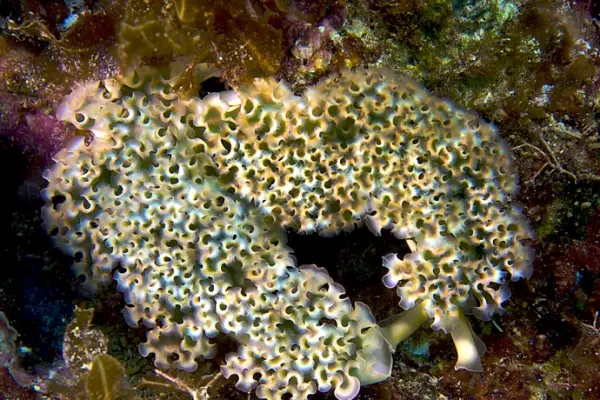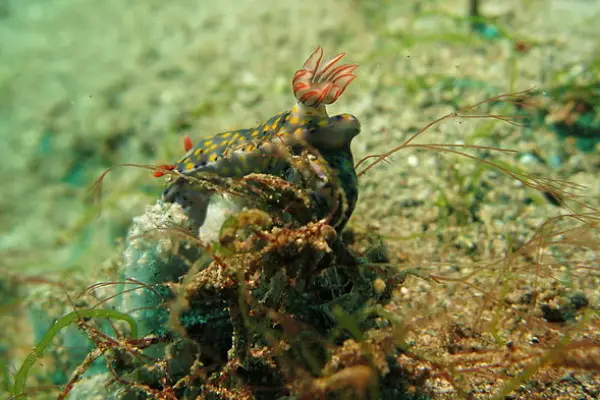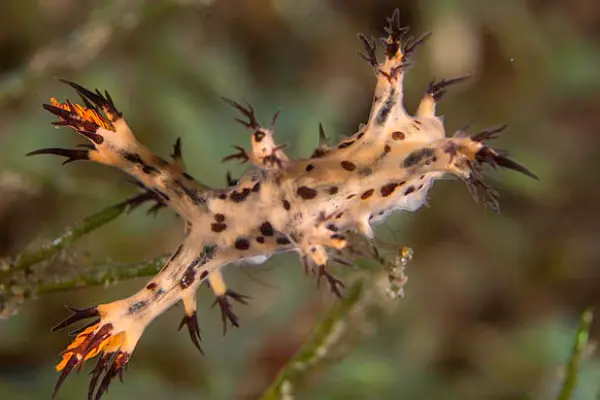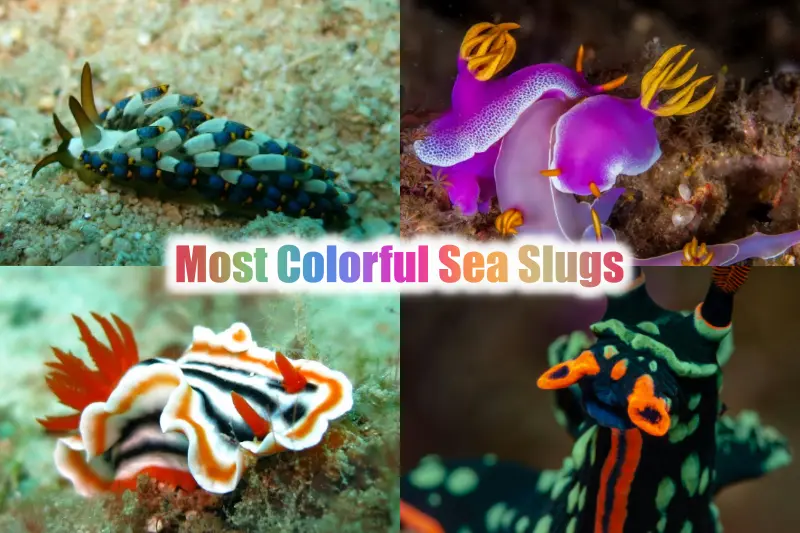Have you ever seen a sea slug? You might find it interesting that sea slugs are a unique species of marine gastropod. Here we are going to closely observe the most colorful sea slugs you can find in the reefs of deep blue oceans on Earth. They had a wide range of colors, from electric blue to bright orange to hot pink. And here, we will look at some of the most colorful ones.
20 Most Colorful Sea Slugs
1. Lettuce Sea Slug

| Scientific name | Elysia crispata |
| Geographical location | Western Atlantic |
| Colors | Green, blue, white, pale, red and yellow |
Elysia crispata, also known as the lettuce sea slug or lettuce slug, is a large and colorful marine gastropod mollusk. It resembles a nudibranch but is classified as a sacoglossan.
The lettuce slug is often green and has a frilly edge to its parapodia, resembling curly lettuce varieties like lollo rosso. Its maximum length is about 5 cm, and its width is 3 cm. The lettuce slug’s color can be blue, pale, red, or yellow.
2. Nembrotha aurea

| Scientific name | Nembrotha aurea |
| Geographical location | Msimbati, Mtwara Region, Tanzania |
| Colors | Red, blue, purple, pale, and black |
Nembrotha aurea is one of the most colorful sea slugs, first described in 2008. This large, creamy-yellow nembrothid grows to at least 30 mm in length and features brown longitudinal lines, reddy-brown rhinophores, an orange-red mantle, white-electric blue gill stalks and branches, and deep red gill pinnae.
Its colorful features include a soft yellow base with dark brown lines, white and bright blue branches, and intense red gills. This species is one of the most colorful sea slugs on the list.
3. Elegant phyllidia
| Scientific name | Phyllidia elegans |
| Geographical location | Red sea and Indo-Pacific ocean |
| Colors | Black, white, and yellow |
Phyllidia elegans, also known as elegant phyllidia, is a sea slug species in the Phyllidiidae family, found in shallow water in the Red Sea and the tropical Indo-Pacific region.
Its distinctive features include a pale-colored foot with a single longitudinal black line, light pink dorsal tubercles, and black lines on the lateral margins of the sole.
4. Hypselodoris infucata

| Scientific name | Hypselodoris infucata |
| Geographical location | Indo-West Pacific Ocean, red sea, and Mediterranean sea |
| Colors | Blue, gray-blue, yellow, black, white, red and brown |
Hypselodoris infucata is among the most colorful sea slugs. It has a translucent white body with blotches of gray-blue, yellow, and black spots. Its gills are white with a single line of red pigment on the outer surfaces, and its rhinophores are opaque white with red edges.
This species can reach a total length of at least 50 mm. You can identify this slug from a similar species by having gills with an outer face forming a triangle.
It lives in tropical Indo-West Pacific regions, including the Red Sea and Mediterranean Sea. Its bright whitish base color, blotches of deep blue and light blue, large yellow spots, and small black dots make it a common Lessepsian migration.
5. Caloria indica
| Scientific name | Caloria indica |
| Geographical location | Indo-West Pacific and Mediterranean Seas |
| Colors | orange, blue, and white |
Caloria indica is a colorful sea slug native to the Indo-West Pacific and Mediterranean Seas. It is an aeolid nudibranch, a marine gastropod mollusk in the family Facelinidae, with a body size ranging from 25 mm to 50mm.
The species is known for its striking, porcupine-like appearance. Most individuals have colors like orange, blue, and white. It was first found off India’s Ambon Island and has since spread to the Mediterranean, primarily near Israel. The species’ colorful features make it a striking sight to behold.
6. Nembrotha lineolata
| Scientific name | Nembrotha lineolata |
| Geographical location | Indo-Pacific, East African coast, Australia, Fiji, and the Solomon Islands |
| Colors | creamy-white, dark brownish, blue, purple, and yellow |
Nembrotha lineolata is a sea slug species found in shallow water in the Indo-Pacific. First described in 1905, it grows to 70mm and has a slender body with a rounded head and pointed tip.
It has a creamy-white body color with narrow longitudinal lines in varying shades of brown, sometimes merging to create transverse bands of color. The type of locality is Selayar Island, Indonesia. The species has three large branchial plumes and an anus.
7. Phyllidia varicosa
| Scientific name | Phyllidia varicosa |
| Geographical location | Indo-West Pacific region, and the Red Sea |
| Colors | blue-gray, black, yellow, and orange |
Phyllidia varicosa is a large sea slug that can grow to 115 mm. This species is distinguished by its numerous longitudinal tuberculate notal ridges. Talking about the coloration they are blue-grey and capped in yellow.
The slug lives in the Indo-West Pacific region, including the Red Sea, and feeds on sea sponges. Its colorful, caterpillar-like appearance serves as a warning to predators, as it is toxic if consumed. The sea cucumber, on the other hand, mimics this species to fool predators into thinking it is also toxic.
8. Hypselodoris zephyra
| Scientific name | Hypselodoris zephyra |
| Geographical location | Madang, Papua New Guinea, Western and Central Pacific Ocean |
| Colors | White, black, orange, red, white, and yellow |
Hypselodoris zephyra is a colorful sea slug species in the Chromodorididae family, known for its white body with black striated lines, purple marginal line on the mantle and foot, and orange-red gills and rhinophores with white tips.
This marine gastropod mollusk can reach a length of at least 20mm and feeds on blue sponges from the Dysidea genus. Its base color ranges from white to soft yellow, with electric purple ringing the bottom of the mantle and vein-like black lines crossing the body. Its rhinophores are lively, burnt orange.
9. Tambja sagamiana
| Scientific name | Tambja sagamiana |
| Geographical location | West Pacific Ocean, Korea, Japan, and Taiwan |
| Colors | Green, yellow, black and blue |
Tambja sagamiana is a colorful sea slug species in the Polyceridae family, found in parts of the West Pacific Ocean, particularly around Korea, Japan, and Taiwan.
Its bright blue body is dotted with yellow-to-orange pustule-like spots, outlined in black, and has green gills and black rhinophores. The species can reach a total length of at least 110 mm and feed on various small marine organisms.
10. Nembrotha purpureolineata
| Scientific name | Nembrotha purpureolineata |
| Geographical location | Western Australia |
| Colors | Blue, red, black, white and brown |
Nembrotha purpureolineata is a colorful sea slug, a dorid nudibranch in the Polyceridae family. It is a large, pale-bodied droid with a creamy white ground color, covered by a large brown patch.
Brown stripes run down the body, and there is a brown band around the head and anterior part of the mantle. The rhinophores are red to orange-red, and the foot is usually edged with purple. Nembrotha purpureolineata can reach a total length of 120 mm.
11. Hypselodoris roo
| Scientific name | Hypselodoris roo |
| Geographical location | Philippines and Indonesia |
| Colors | Yellow, black-blue, orange and red |
Hypselodoris roo is a marine gastropod mollusk in the Chromodorididae family, often mistaken for Hypselodoris kanga. It has a white body covered with yellow and blue-black spots, orange-red lines on the outer edges, and bright red clubs and bases.
The species can reach a total length of at least 45 mm. Mostly they are found off the coast of the Philippines and Indonesia. Its distinctive patterning makes it look like the ocean floor when dappled by sunlight.
Its base color is blue-gray, and its rhinophores add an unexpected burst of red. This bright, blob-like nudibranch is one of the more colorful ones on our list, with its rhinophores resembling pointy horns.
12. Gem Sea Slug
| Scientific name | Goniobranchus geminus |
| Geographical location | Indian Ocean, Kenya, Sri Lanka, and the Red Sea |
| Colors | Yellow, white, brown, blue, and purple |
Goniobranchus geminus, also known as the gem sea slug, can reach a maximum length of 5 cm and has four distinctive colored lines around its mantle edge. The background coloration is light brown to yellowish, speckled with mauve ocelli circled with a white margin.
The foot has clearer, white margins, rhinophores, and gills outlined with beige. Goniobranchus geminus lives in coral reefs in the Red Sea and Indian Ocean and can grow up to 2 inches long.
Its colorful features include a whitish base color, pale bluish-purple, and yellow mantles, a rosy hue, and purple spots surrounded by white rings.
13. Nembrotha chamberlaini
| Scientific name | Nembrotha chamberlaini |
| Geographical location | Philippines |
| Colors | orange, yellow, green, or black |
Nembrotha chamberlaini is a colorful sea slug, a dorid nudibranch in the Polyceridae family, first described in 1997. It is white with streaks of orange, yellow, green, or black, and occasionally yellow splashed across the upper mantle. It has distinctive bright red gills and rhinophores, and its foot and mouth parts are typically light-purple.
This nudibranch has a characteristic color pattern that is typical of species that display warning coloration to other species.
N. chamberlaini can reach a length of 100 mm and is found off the coasts of the Philippines and Indonesia. Its distinctive bright colors are believed to warn predators of its toxicity.
14. Variable Neon Slug
| Scientific name | Nembrotha kubaryana |
| Geographical location | Western Pacific Ocean |
| Colors | Green, red, orange |
Nembrotha kubaryana, also known as the variable neon slug or dusky nembrotha, is a colorful sea slug in the Polyceridae family.
Moreover, it is a large, dark-bodied nudibranch with green stripes running down its body or raised spots and a vivid red-orange margin on its foot and head. It can reach over 120mm in length and found in tropical parts of the western Pacific Ocean and is known for its dark stripes.
15. Chromodoris quadricolor
| Scientific name | Hypselodoris variobranchia |
| Geographical location | Australia, Indonesia, Malaysia, and Japan |
| Colors | Purple, orange, white |
Hypselodoris variobranchia is a sea slug or dorid nudibranch in the Chromodoridae family, known for its deep purple body and orange rhinophore bulb. It is found off the coasts of Australia, Indonesia, Malaysia, and Japan.
You might find it interesting that this species of slug can reach up to 50 mm in length. This large nudibranch is known for its colorful features, such as a broad white ring surrounding its mantle and orange gills and rhinophores.
16) Dendrodoris guttata
| Scientific name | Dendrodoris guttata |
| Geographical location | Australia |
| Colors | Black, orange, white, |
Dendrodoris guttata is a species of sea slug, a dorid nudibranch, found in tropical waters off Australia’s coast. It measures at least 2 inches long and primarily feeds on sea sponges. The bright orange-colored individuals have black spots ringed in a soft, whitish glow.
Some species resemble land slugs, while this unique species is amorphous, resembling a glistening, spreading blob. Its bright pattern sets it apart from other sea slugs.
17) Cabangus regius

| Scientific name | Cabangus regius |
| Geographical location | Malaysia |
| Colors | White, pink, brown, orange |
Cabangus regius is a small dendronotid nudibranch, a shell-less marine gastropod mollusc in the Dendronotidae family. It grows up to 30 mm and has a translucent white body with a milky white to pink surface.
The tips of dorsal appendages and rhinophore sheath processes are dark brown, and the rhinophore clubs are bright orange. Some specimens have extensive orange pigment, while a similar animal with raised tubercles and dark brown clubs is likely a distinct species.
18) Opalescent Sea Slug
| Scientific name | Hermissenda opalescens |
| Geographical location | west coast of North America, from Oregon to Baja California |
| Colors | Blue, yellow, and brown |
Hermissenda opalescens is a brightly colored sea slug in the family Facelinidae, measuring 50mm or 2 inches. It has been used as a model organism in studies on classical conditioning, memory consolidation, associative learning, neural circuit structure, and neural physiology.
However, these studies did not differentiate between the three species of Hermissenda, resulting in a lack of understanding.
19) Purple Mediterranean Sea Slug
| Scientific name | Flabellina affinis |
| Geographical location | Atlantic Ocean, Europe, and the Mediterranean Sea |
| Colors | Purple, white |
Flabellina affinis is a sea slug species found in parts of the Atlantic Ocean off the coast of Europe and the Mediterranean Sea. It is about 2 inches long and feeds on small, predatory marine animals in the Eudendrium genus.
The species is particularly common in the Mediterranean Sea, where it is easily visible during snorkeling or diving.
Flabellina affinis is part of the aeolid nudibranch clade and can grow up to 50mm in length. It is often confused with Paraflabellina ischitana, but can be distinguished by its opaque violet coloration beneath the subapical white ring.
20) Nembrotha mullineri
| Scientific name | Nembrotha mullineri |
| Geographical location | Philippines |
| Colors | White, black, brown, blue |
Nembrotha mullineri is a colorful sea slug, a dorid nudibranch in the Polyceridae family, first described in 1997. This white-black nembrothid grows to at least 50mm in length and has a creamy-white body with longitudinal black-brown lines. It is found off the coast of the Philippines and is at least 2 inches long.
The slug’s striking patterning, whitish with thin dark lines and spots, resembles a blue roan horse or merle dog. Although not extremely bright, its intricately beautiful pattern earns it a spot on the list.
Conclusion:
These are some of the most colorful sea slugs you can’t find easily in the water but in the deep blue oceans. They normally like to live among the coral reefs. Despite their beautiful colors, these creatures are still not that popular. If you want to know more about such creatures, keep looking for them on HowItSee.
Reference:
- Wikipedia
Also Read:

As a content writer, I like to write about different niches. I have a curiosity about nature and animals. And like to learn about them. Through my writing, I like to share my experience and knowledge with you. I hope you are enjoying it too.

